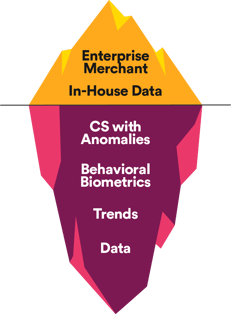How Enterprise Ecommerce Merchants Lose Revenue Fighting Fraud
When we first talk to enterprise ecommerce merchants about fraud protection, we’re often told they have their fraud under control.
And they do – but at what cost?
The reality is, many enterprise merchants do have some variation of a fraud strategy, but they may not realize how much their fraud prevention practices are costing them in lost revenue.
Why the Typical Enterprise Approach to Ecommerce Fraud Is Flawed
Larger enterprises process thousands of transactions on a weekly (sometimes daily) basis. As such, they’re also hit with many more fraud attempts than their small-business brethren.
Because of this volume, enterprise merchants can’t rely solely on manual review. So, they typically use fraud filters with rules designed to decline any transaction that looks like it could be fraudulent. Combined (not always, but often) with in-house analysis, this approach to fraud prevention is considered satisfactory by a large number of enterprise ecommerce merchants.
However, the phrase “you don’t know what you don’t know” applies with unnerving precision here.
There are several revenue-damaging pitfalls to the typical enterprise fraud protection approach, and these pitfalls often result in lost revenue:
- Merchants may not have as broad a picture of the fraud landscape as they should.
- Their manual review team may struggle with training and scaling.
- They might be a little too cautious.
- They might miss other types of fraud.
Fraud never grows in a straight line—it’s always dynamic. The good news? A more sophisticated fraud prevention strategy can keep ahead of fraudsters while preventing lost sales.
Let’s take a closer look at how enterprise ecommerce merchants handle fraud protection and the ways we help them mitigate their fraud prevention pitfalls.

Enterprise Ecommerce Merchants View Fraud From a Limited Lens
Despite their large size, enterprise ecommerce merchants approach fraud with a narrow focus.
Merchants Have Limited Insight and Predictability
Enterprise merchants have little to no insight into fraud patterns and trends by industry, country, or other aggregators. In fact,

Yes, they can make some predictions about year-to-year behaviors on peak traffic days like Black Friday, but that’s still a very small part of a much larger picture.
Fraud Detection Is More Complicated Than Ever
The pandemic has made fraud prevention even more complicated. After all, ecommerce revenues jumped forward five to seven years in just one year. That means even more transactions to potentially hide fraud.
The number of new ecommerce users has also jumped, which is great news. However, many ecommerce merchants don’t have insight into the differences in behavior between seasoned shoppers and novices. As a result,

ClearSale’s Fraud Lens Is Global
Because we work with enterprise businesses around the world, we gain deeper insight into fraud patterns and trends, and how they’re affecting different markets. We then use those insights to inform our fraud prevention decision-making.
“The ‘iceberg effect’ is where merchants look at a small subset of data – like the top of an iceberg – to look for fraud. We go deep into the water to see the behaviors, trends, and data that provide a much clearer identification of which transactions are actually fraudulent.”
 Rafael Lourenco
Rafael Lourenco
ClearSale Executive Vice President and Partner
Our massive database of transactions allows us to see fraud trends as they emerge. We utilize AI-enabled automation to assess transactions against behavioral biometrics and trends. And our manual review process adds another layer of accuracy.

Enterprise Ecommerce Merchants Use an “All Hands on Deck” Approach
Not all enterprise merchants use manual transaction review – and if they do, it may only be when they know they’re being targeted.
The problem is there is no warning for that situation.
Within a day, the company’s fraud analysts can become completely overwhelmed with the task of manually reviewing thousands of transactions. That’s when they pull resources from other departments – usually, customer service and warehouse staff – to help. Unfortunately, none of these employees have fraud detection training or expertise. And the time they spend reviewing transactions is time taken away from their other responsibilities.
“Unless an organization makes a decision to grow and train their fraud team internally, they will struggle to scale with the ebb and flow of transactions and fraud targeting.”
Sarah Elizabeth, Senior Director of Marketing at ClearSale
ClearSale Helps Scale and Train Your Fraud Staff
Manual review doesn’t have to be that difficult for enterprise merchants. Many have avoided the scaling and training issue altogether by outsourcing their manual review to us. Others keep us on hand to take care of overflow during sales peak periods. Many in this latter group also bring us in to train their existing fraud prevention team on how to more easily and accurately detect fraud.

Enterprise Ecommerce Merchants Are Overzealous With Declines
Too often, the pressure to reduce fraud causes enterprise merchants to resort to strict policies, business rules, and filters.
Their intention is good, but the execution creates an even bigger problem.
A rigid approach to automated fraud prevention can easily impact a merchant’s transaction approval rate. That alone is cause for concern, but what is more worrisome is what happens when those declined transactions were valid.
In ClearSale’s 2021 Global Ecommerce Consumer Behavior Analysis, customers revealed how unforgiving they are when they’re mistaken for fraudsters:
- 39% said they would never buy from that site again
- 28% said they would post about their bad experience on social media.
Enterprise merchants have to walk a fine line between detecting and declining fraudulent transactions, providing exceptional Customer Experience (CX) and User Experience (UX), and optimizing revenue. Without help, it can be a daunting task.
ClearSale Helps Merchants Recover Lost Revenue and Reduce False Declines
Many large enterprises say they don’t have a fraud problem, but our data scientists almost invariably find that they do have a revenue problem.
“In a typical enterprise merchant review, we will find between 1% and 2% of revenue left on the table due to declined transactions. That can equate to tens of millions of dollars of lost revenue.”
David Fletcher, Senior Vice President at ClearSale
When we work with clients, one of our auditing programs uses a control group review to systematically compare the result of approving a random set of transactions with declining them. (Of course, it’s done in a quasi-test environment with no impact on the client’s revenues.) This audit evaluates the accuracy of automated rules and identifies the adjustments needed to improve accuracy.

Enterprise Ecommerce Merchants Overlook Other Fraud-Related Issues
In addition to account takeover (ATO), card not present (CNP), and other traditional types of fraud, enterprise ecommerce merchants are often the unlucky targets of non-traditional schemes that can still eat away at their bottom line.
Loyalty Fraud
Loyalty fraud is usually associated with ATO, where a fraudster assumes a customer’s loyalty points and uses them to redeem benefits.
Typically, we address this by identifying abnormal behaviors, such as too many orders for the same user, IP address, or device. Those orders undergo a more in-depth review process to confirm whether they are legitimate or not. We also look for multiple transactions paid mostly or in full using loyalty points, as it can be another indicator of potential loyalty fraud.
Return Abuse
This form of friendly fraud happens when a customer makes a purchase they don’t intend to keep.
We track this type of fraud using machine learning and rules that score a customer’s return percentage versus exchange percentage. In the case of high-risk orders, manual reviews are definitely recommended, given the costly impact these transactions can have on a merchant’s bottom line.
Promotion/Coupon Abuse
Promotion or coupon abuse usually involves a person creating multiple accounts to take advantage of an offer or coupon multiple times. It can also involve overuse of a coupon.
Similarly to return abuse prevention, we combine merchant policies with machine learning and manual review. Many times, these prevention strategies help to detect large-scale crime rings and mass registered fake accounts.
Reshipping, Triangulation, and Package Rerouting Fraud
There is virtually no limit to the schemes that fraudsters will create and try to implement, especially, with enterprise ecommerce merchants.
For reshipping, triangulation, package rerouting, and other types of non-traditional fraud, ClearSale leverages specific data points, fraud scores, and rules to identify risky patterns. Manual review is almost always used to validate potentially fraudulent transactions of these types.

ClearSale Helps Enterprise Ecommerce Merchants Optimize Revenue
At ClearSale, our experienced fraud analysts can augment any team, increase your staff’s existing knowledge, and keep your organization updated on the latest fraud trends. We can integrate our fraud solution at any point in the customer journey. As a result, we help enterprise ecommerce merchants recover lost revenue and reduce false declines while improving your fraud prevention strategy.
To learn more about how ClearSale has helped other enterprise merchants fight fraud and maximize revenue, our team is available to chat.
 Rick Sunzeri
Rick Sunzeri





